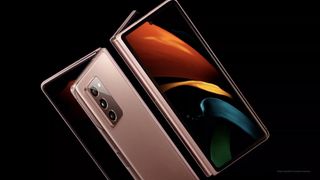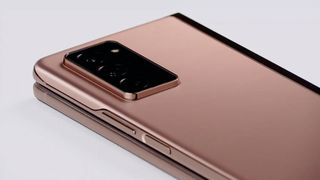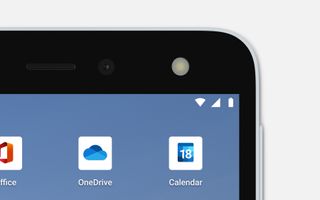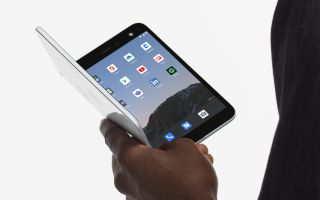Microsoft Surface Duo vs. Samsung Galaxy Z Fold 2: Which foldable will win?
![]()
The Microsoft Surface Duo and Samsung Galaxy Z Fold 2 are both technically foldable phones, though that’s about all they share in common.
Whereas Samsung’s second-generation Galaxy Fold offers a massive, flexible OLED panel, Microsoft has gone a more traditional route with the Surface Duo, offering two separate 5.6-inch screens protected by glass that form an 8.1-inch canvas when folded out.
But that’s not the only way in which these two devices will differ. Under the hood, they’re powered by different processors, sport differently-sized batteries and tout completely unique camera hardware. And the Galaxy Z Fold 2 will assuredly pack a few conveniences you won’t find on the Surface Duo, which Microsoft is still reluctant to even classify as a phone.
Many details about the Galaxy Z Fold 2 are still shrouded in mystery, though Samsung says we can expect to learn more on September 1. This Microsoft Surface Duo vs. Samsung Galaxy Z Fold 2 comparison will highlight all the significant ways in which 2020’s most radical flagship Android phones differ.
Surface Duo vs. Galaxy Z Fold 2: Price and release date
The Microsoft Surface Duo begins shipping September 10 and starts at $1,399 for a device with 128GB of storage. You can upgrade that to 256GB by spending another $100, which you’ll have to do if you ever want more storage in your Surface Duo, as it has no microSD slot for expandability. You can either purchase the phone unlocked, where it will support all major networks in the U.S., or go directly through AT&T.
Meanwhile, we still don’t know how much the Samsung Galaxy Z Fold 2 will cost, let alone when you’ll be able to buy one. The first-generation Samsung Galaxy Fold cost $1,980, and rumors have suggested the sequel could be $200 cheaper at most. That would still place it at roughly $400 more than the Surface Duo, which itself is already a very expensive phone.
Surface Duo vs. Galaxy Z Fold 2: Specs
| Microsoft Surface Duo | Samsung Galaxy Z Fold 2 (rumored) | |
|---|---|---|
| Price | $1,399 | ~$1,780-$1,980 |
| Display | Two 5.6-inch AMOLED (1800×1350); 8.1 inches combined | 7.6-inch interior OLED (120Hz); 6.2 exterior OLED |
| Processor | Snapdragon 855 | Snapdragon 865/865 Plus |
| RAM | 6GB | 8GB-12GB |
| Storage | 128GB, 256GB | 256GB, 512GB |
| Primary cameras | 11MP (ƒ/2.0) | 12MP or 108MP main camera; 12MP ultrawide; 64MP telephoto with 3x lossless zoom |
| Additional cameras | N/A | 10MP front facing |
| Battery size | 3,577 mAh | TBA |
| Size | Closed: 5.71 x 3.67 x 0.39 inches; Open: 5.71 x 7.35 x 0.18 inches | TBA |
| Weight | 8.8 ounces | TBA |
Surface Duo vs. Galaxy Z Fold 2: Design and display

Are two displays better than one? Microsoft hopes you’ll think so, as the Surface Duo packs dual 5.6-inch PixelSense AMOLED displays shrouded in strengthened glass, with big bezels above and below the panels. The entire device is exceptionally thin — the Surface Duo only measures 4.8 millimeters thick when outstretched — making it the thinnest folding phone or Surface ever built.
The Galaxy Z Fold 2 actually has two displays as well, though you can’t really look at them at the same time. The one on the inside of the device measures 7.6 inches from corner to corner, and sports the same 120Hz refresh rate as the new Galaxy Note 20 Ultra.

That panel is protected by Samsung’s Ultra-Thin Glass, which offers more reliability compared to the fragile plastic substrate used on the original Galaxy Fold, though not anywhere near the same sort of rigidity and protection as what the Surface Duo offers. On the outside of the Galaxy Z Fold 2 is another 6.2-inch screen which essentially functions like that of a normal phone.
The Galaxy Z Fold 2 measures 6mm thick, which will make it quite a bit heftier than the Surface Duo when folded up. Both phones sport nifty hinges: the Surface Duo’s hinge rotates a full 360 degrees and can stop at any point. The Galaxy Z Fold 2’s can also stop anywhere along its path, though it’s restricted between folding shut and opening so the interior screen lays flat.
Surface Duo vs. Galaxy Z Fold 2: Cameras

Avid mobile photographers will likely flock to the Galaxy Z Fold 2 before giving the Surface Duo any consideration. That’s because Samsung’s foldable sports three lenses, with one of them likely to be a high-megapixel sensor, while the Surface Duo has only one above its right display.
We don’t know the specifics of the Galaxy Z Fold 2’s camera stack, but rumors point to the device either incorporating the primary 12-MP shooter from the Samsung Galaxy S20 Plus or the 108-MP sensor first utilized in the Galaxy S20 Ultra and, more recently, the Note 20 Ultra. It’ll likely be supplemented by ultra wide and telephoto cameras, with the latter potentially offering 64-MP shots with 3x lossless zoom, like on the two cheaper Galaxy S20 models.

As for the Surface Duo, don’t expect anything earth shattering. Microsoft has made it clear this phone is not meant primarily for shutterbugs, with a single 11-MP, ƒ/2.0 shooter above one of the screens. That means you’ll have to fold the phone back if you want to take a picture of something in front of you.
Microsoft stresses the Surface Duo’s single-lens system still leverages artificial intelligence and computational photography to achieve tricks like a shallow depth-of-field portraits and a dedicated low-light mode. That said, we’d be lying if we expected the Surface Duo’s camera quality or versatility to strike anywhere near the Galaxy Z Fold 2’s, let alone one of the best camera phones. It simply doesn’t appear to be a focus of the Surface Duo, and the specs sheet suggests as much.
Surface Duo vs. Galaxy Z Fold 2: Performance

Here’s another area where the Surafce Duo and Galaxy Z Fold 2 are expected to differ massively. Microsoft’s $1,399 handset utilizes last year’s Qualcomm Snapdragon 855 chipset and 6GB of RAM, whereas Samsung’s foldable is likely to incorporate the same Snapdragon 865 Plus silicon as the Galaxy Note 20 and as much as double the memory in Microsoft’s device.
Again, we don’t exactly know what Samsung is planning for the Galaxy Z Fold 2, though we can glean as much from the company’s current range. Whether the company chooses the standard Snapdragon 865 architecture that was first introduced in the Galaxy S20, or the faster 865 Plus, the Galaxy Z Fold 2 will also support 5G networks — something you certainly won’t find in the Surface Duo, which is only built to connect to 4G LTE towers.
We’re expecting a sizable gap in performance between these two phones. The Snapdragon 855 isn’t woefully out of date, but its CPU is 20% slower, and its GPU is 25% slower than those in the regular 865. The 865 Plus adds even more horsepower on top of that, so Samsung’s device will surely pack a little extra oomph for workaholics and hardcore gamers.
Surface Duo vs. Galaxy Z Fold 2: Battery

With two screens to power, you’d imagine the Surface Duo would pack an absolutely gigantic battery. Yet Microsoft has only built a 3,577-mAh power pack into its first Android handset, which is quite small compared to the 4,500-mAh one inside the Galaxy Note 20 Ultra.
Much like with other specs relating to the Galaxy Z Fold 2, we still don’t know what Samsung plans to put inside its foldable to keep it powered throughout the day. However, the first Galaxy Fold had a 4,380-mAh battery, and that device didn’t even tout a 120Hz refresh rate or 5G connectivity. With the increased power demands of its modern flagships, we imagine Samsung will increase the second-generation Fold’s battery capacity to accommodate.
Amazingly, Samsung baked wireless charging support into the original Galaxy Fold, and we expect it to make a return in the sequel as well. The Surface Duo unfortunately makes no provisions for wireless charging nor NFC, which is pretty disappointing given the high price.
Surface Duo vs. Galaxy Z Fold 2: Software and special features

Microsoft is hoping that Surface Duo owners will find that what the dual-screen phone lacks in hardware, it’ll make up for in clever, intuitive software. The Surface Duo is built to seamlessly move you between its two displays in a logical way that keeps you on task and helps you work smarter.
For example, if you open an email in the Surface Duo’s Outlook app, it’ll populate the unused screen with the contents of the message you’ve just tapped, leaving your inbox open on the first panel. And if you want to reply, it’ll slide the correspondence over to replace your inbox and make room for a compose menu.

Microsoft says the APIs it’s built atop Android on the Surface Duo are smart enough to know what apps and links to put where and when, meaning third-party developers don’t have to purposefully code their apps to take advantage of the Surface Duo’s multiple panels.
As for the Galaxy Z Fold 2, Samsung hasn’t shared any specific productivity-minded features as of yet. That said, the first Fold did have a nifty App Continuity feature, whereupon an app open on the outside display would move to the interior screen for a larger look when you opened the device. We imagine that idea will be carried over to the Galaxy Z Fold 2 and potentially expanded.
What’s more, with practically all Samsung flagships these days supporting DeX mode for a makeshift desktop experience when you need it, we hope to see the company’s new wireless DeX interface, introduced alongside the Note 20, appear in its next foldable as well.
Both Microsoft and Samsung have committed to three years of Android platform updates for their phones, which give anyone who spends top dollar on one of these devices peace of mind.
Surface Duo vs. Galaxy Z Fold 2: Outlook
Obviously, the Surface Duo and Galaxy Z Fold 2 are very different sorts of foldables — so different, in fact, that they may attract entirely different users.
The Surface Duo is for the productivity-minded crowd that could really benefit from the phone’s windowed motif and multitasking-focused interface. It’s also a good companion for those who actively use many Microsoft services.
The Galaxy Z Fold 2 is more of a media powerhouse, with its far more sophisticated camera technology and unencumbered flexible display. It’s also for the user excited about the future of foldable panels and mobile technology as a whole. Using a device like the Galaxy Fold or Galaxy Z flip is a magical experience the very first time you do it, and it’s certainly flashier than the seemingly well-built but ultimately more traditional Surface Duo.
We look forward to a more in-depth comparison between these two devices once the Galaxy Z Fold 2 fully launches, and we’re able to get the Surface Duo in for testing. Stay tuned.
![Hurry! Amazing iPhone SE deal is just $184 right now [UPDATE] Hurry! Amazing iPhone SE deal is just $184 right now [UPDATE]](https://styleandeasy.com/wp-content/uploads/2020/04/hurry-amazing-iphone-se-deal-is-just-184-right-now-update_5ea504e5bdde3-390x205.jpeg)
